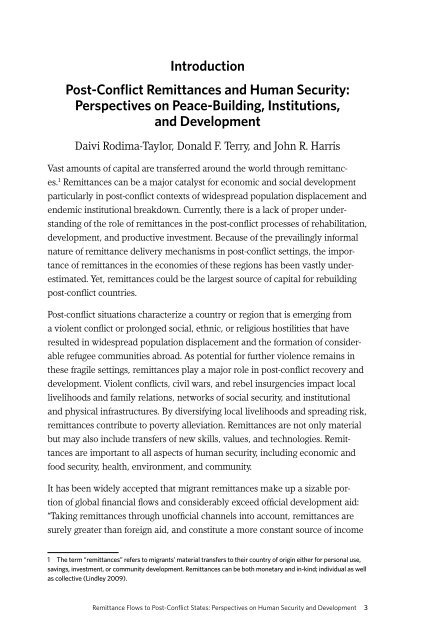Pardee-CFLP-Remittances-TF-Report
Pardee-CFLP-Remittances-TF-Report
Pardee-CFLP-Remittances-TF-Report
You also want an ePaper? Increase the reach of your titles
YUMPU automatically turns print PDFs into web optimized ePapers that Google loves.
IntroductionPost-Conflict <strong>Remittances</strong> and Human Security:Perspectives on Peace-Building, Institutions,and DevelopmentDaivi Rodima-Taylor, Donald F. Terry, and John R. HarrisVast amounts of capital are transferred around the world through remittances.1 <strong>Remittances</strong> can be a major catalyst for economic and social developmentparticularly in post-conflict contexts of widespread population displacement andendemic institutional breakdown. Currently, there is a lack of proper understandingof the role of remittances in the post-conflict processes of rehabilitation,development, and productive investment. Because of the prevailingly informalnature of remittance delivery mechanisms in post-conflict settings, the importanceof remittances in the economies of these regions has been vastly underestimated.Yet, remittances could be the largest source of capital for rebuildingpost-conflict countries.Post-conflict situations characterize a country or region that is emerging froma violent conflict or prolonged social, ethnic, or religious hostilities that haveresulted in widespread population displacement and the formation of considerablerefugee communities abroad. As potential for further violence remains inthese fragile settings, remittances play a major role in post-conflict recovery anddevelopment. Violent conflicts, civil wars, and rebel insurgencies impact locallivelihoods and family relations, networks of social security, and institutionaland physical infrastructures. By diversifying local livelihoods and spreading risk,remittances contribute to poverty alleviation. <strong>Remittances</strong> are not only materialbut may also include transfers of new skills, values, and technologies. <strong>Remittances</strong>are important to all aspects of human security, including economic andfood security, health, environment, and community.It has been widely accepted that migrant remittances make up a sizable portionof global financial flows and considerably exceed official development aid:“Taking remittances through unofficial channels into account, remittances aresurely greater than foreign aid, and constitute a more constant source of income1 The term “remittances” refers to migrants’ material transfers to their country of origin either for personal use,savings, investment, or community development. <strong>Remittances</strong> can be both monetary and in-kind; individual as wellas collective (Lindley 2009).Remittance Flows to Post-Conflict States: Perspectives on Human Security and Development 3


